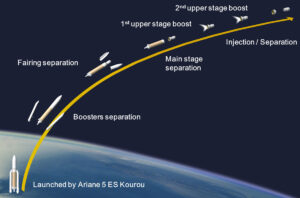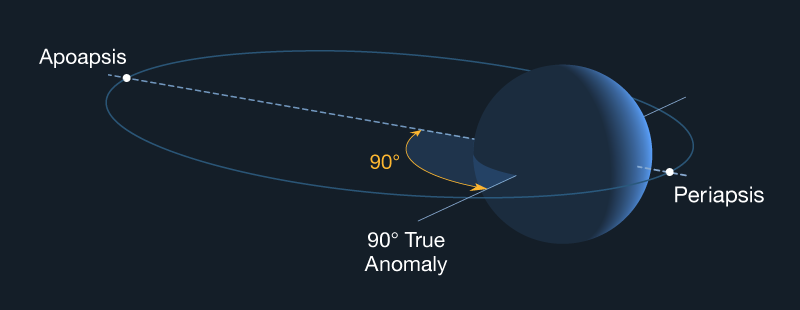The shortest route for the satellites to take from the launching base to its assigned orbit would be the vertical one. This, however, is not feasible in actual practice for the simple reason that the gravitational pull of the earth will then be in the directly opposite direction to its motion and counteract the pull of the engines. So that, before it can gather the necessary speed, its limited fuel-stock may get exhausted, resulting in its first coming to a stop and then starting falling down. Vertical launching of the satellite is, therefore, not a practicable proposition.
To ensure that the satellite does not fall back to the earth, it is essential to give it a sufficient horizontal velocity. Its upward flight is, therefore, so arranged that it is brought into its orbit in the shortest possible time, acquiring meanwhile the requisite horizontal velocity. It is thus clear that the particular trajectory that will take the satellite to its assigned orbit has first to be most carefully calculated.
It is usual to arrange the first portion of the flight of the rocket to be vertical, so that it may pass through the first 20 km of the denser portion of the atmosphere the earliest. Thereafter, as it enters the rarefied portion of the atmosphere, it is given a gradual tilt by means of a mechanical pilot, so that it emerges into its orbit with a horizontal velocity large enough for the centrifugal force coming into play on it, (on account of its circular motion) to just balance the force due to the gravitational pull.
The trajectory of its path is so chosen that the loss of velocity entailed, due to air resistance and the earth’s pull, is a small percentage of its requited or characteristic velocity.
In fact, to make up for this loss, the actual velocity given to it is a little higher than the computed value of its characteristic velocity. When launched laterally to the earth’s rotation, however, an increase in its velocity is automatically obtained at the expense of the velocity of the earth’s rotation, depending upon the latitude of the launching site. Thus, for example, this increase is the maximum at the equator, being as much as 400 meters/sec, which is higher than that of the fastest fighter planes of the day.

If it be desired to give the satellite an elliptical orbit, instead of a circular one, the rocket carrying it must either be given a higher velocity than. the peripheral one or its velocity, immediately after completion of the motor’s performance, must not be directed along the tangent to the circular orbit. In the elliptical orbit, the point nearest to the earth is called ‘perihe’ and the farthest from it, the ‘acme’. And it is quite possible that the satellite at the farmer point may be nearer to, and at the latter, farther from, the earth than at any point in its circular path.
In any case, the accuracy. demanded in the firing of the rocket into its correct orbital path is really exacting. For, even an error of I% in the direction of velocity may produce a height variation of the perihe and the acme which may be as much as 120 km or more. This firing accuracy is secured by means of proper steering devices, directing the course of the rocket at every stage of its flight and, clearly, rudders of the type used in the ordinary jet aircraft, are hardly suitable for the purpose, since they cannot possibly function equally effectively both in the denser and the rarefied regions of the atmosphere.

The necessary steering control can, however, be effected in a number of ways but the one usually resorted to is to so design the rocket as to enable it to change the direction of the escaping jet by a mere tilt of the longitudinal axis of its motor with respect to its own. This is actually the device adopted in most of the present-day long-range rockets.
The manner in which the angle of inclination of the longitudinal axis of the rocket with the horizon is varied, will be clear from picture. As will be readily seen, the trajectory of the rocket from its very start until its longitudinal axis takes up the horizontal position, (i.e., until its outward motion towards its orbit) is split up into a number of stages, indicated by h1, h2, h3 etc., depending upon the height of the orbit.
The angles that its horizontal axis makes with the horizon at each stage is carefully calculated beforehand and the control instruments set accordingly, to ensure that the rocket takes its assigned trajectory. And, this very setting of the instruments also regulates the fuel-supply in keeping with the pre-determined requirement at the time.
Now. it will be easily understood that, while going round in its allotted orbit, the satellite passes over different parts of the globe in its successive rounds. For, by the time it has completed one round, the earth has also rotated about its axis and hence, in its next round, it naturally passes over other parts that now fall below its orbit. This will ‘always be so except when the satellite goes round an orbit coinciding with the equatorial plane, in which case, obviously, it will always pass over the same parts or countries situated at the equator.
It does not mean that we can launch the satellite in any orbit we choose. For, the orbit must be one such that is plane passes through the center of the earth and it will, therefore, clearly depend upon the site of launching.
Not only that, but even the time of the day and the season at the time of launching matter a great deal. For, a satellite receives energy direct from the sun through special type of solar batteries fitted into it, a particular side of which must all along be illuminated by the sun. The satellite must, be launched in an orbit, the plane o which perpendicular to the rays of the sun, and this is possible only at a particular hour of the day i.e. when the radius of the earth connecting the starting point of the satellite with its center is perpendicular to the sun’s rays.





